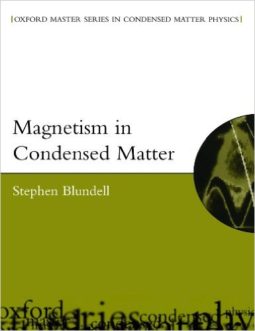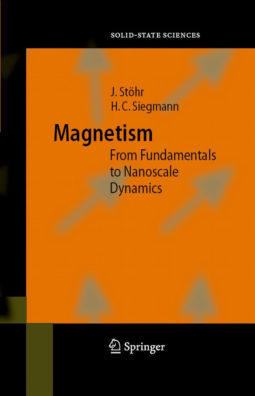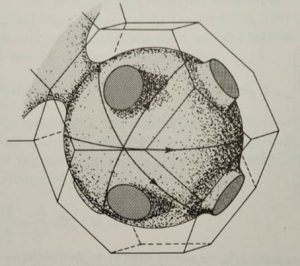



Course outline: The outline will be available soon.
Class timings: 3:30 to 4:45 pm, Tuesday and Thursday, Room: 302 SSE Complex.
Class timings: 2:00 to 3:00 pm, Monday and Wednesday, Room: 9-103A (Dr. Sabieh’s office) SSE Complex.
Pre-mid term
1: Isolated magnetic moments and paramagnetism (3 lectures)
- Magnetic moments, Spin 1/2 particle, Spin j system, Paramagnetism, temperature and magnetic field dependence, forces on moments, torque on moments, Bloch equation, relaxation, quantum mechanics description of magnetic resonance phenomena (Stohr: Chapter 3) | Homework 1
2: The exchange interaction (4 lectures)
- A bird’s eye view of interactions: Zeeman, dipolar, exchange, spin-orbit, hyperfine, magnetic phenomena, the symmetrization pustulate, exchange interaction explained by electrons in the helium atom, the hydrogen molecule and exchange in chemical bonds. Here is a description on the origin of exchange for the two electrons inside the He atom; taken from Sakurai’s “Modern Quantum Mechanics”. (Stohr: Chapter 6, Sections 6.1, 6.2, 6.3.1 to 6.3.4) | Homework 2
3: The exchange Hamiltonian (5 lectures)
- The exchange Hamiltonian and examples, spin waves and magnons in ferromagnetic and antiferromagnetic structures, second quantization treatment, Fourier and Holstein-Primakoff transformations, the Bogoluibov transformation, density of states for magnons, magnon number, energy and heat capacity due to magnons. See Frank Kruger’s notes (Chapter 4 here.) | Homework 3 and Homework 4. The midterm exam can be downloaded from here.
4: Magnetism in free and almost-free electrons (6 lectures)
 The free electron model, Pauli paramagnetism, Landau quantization, density of states and integrated density of states in the presence of a magnetic field, magneto-oscillatory phenomena, Fermi energy in the presence of a magnetic field, Shubnikov de-Haas oscillations, de Haas-van Alphen oscillations, Landau diamagnetism, finding the shape of the fermi surface using magnetic oscillations. Chapters 4 and 5 in M.S. Dresselhaus’s Lecture Notes on “Magnetic Properties of Solids” are an excellent resource that covers these topics in the detail that we cover in this course. Sections 3.4 and 3.5 of Nolting and Ramakanth are a definitive standard in an analytical derivation of magnetic oscillations using the grand canonical ensemble approach. Furthermore, this compressed file contains a Mathematica notebook, its PDF version and a powerpoint file. The Mathematica notebook contains code for making plots of the various properties of the Landau quantized system. Homework 5
The free electron model, Pauli paramagnetism, Landau quantization, density of states and integrated density of states in the presence of a magnetic field, magneto-oscillatory phenomena, Fermi energy in the presence of a magnetic field, Shubnikov de-Haas oscillations, de Haas-van Alphen oscillations, Landau diamagnetism, finding the shape of the fermi surface using magnetic oscillations. Chapters 4 and 5 in M.S. Dresselhaus’s Lecture Notes on “Magnetic Properties of Solids” are an excellent resource that covers these topics in the detail that we cover in this course. Sections 3.4 and 3.5 of Nolting and Ramakanth are a definitive standard in an analytical derivation of magnetic oscillations using the grand canonical ensemble approach. Furthermore, this compressed file contains a Mathematica notebook, its PDF version and a powerpoint file. The Mathematica notebook contains code for making plots of the various properties of the Landau quantized system. Homework 5
5: Itinerant Magnetism (4 lectures)
- The tight-binding Hamiltonian, concept of energy bands and conductivity, second quantization form of single-particle and two-particle operators, modeling Coulombic repulsion between free electrons and writing the Hamiltonian in the Hartree-Fock approximation, Hartree-Fock energies, competition between kinetic and potential energies and prediction of when a system of itinerant electrons can become ferromagnetic (weakly or strongly). See Section 6.6 of the book Solid State Theory by Ulrich Rossler. Here are some of my lecture notes on the second quantization representation of a Fermi gas of electrons interacting through the Coulomb interaction. Homework 6
6: Mean-field models (3 lectures)
- The Stoner model, Hubbard model, Mott insulators, mean field and Weiss theory for ferromagnetism, antiferromagnetism and ferrimagnetism, why are certain materials ferromagnetic; an explanation using Stoner criteria and band diagrams, a look at the periodic table.